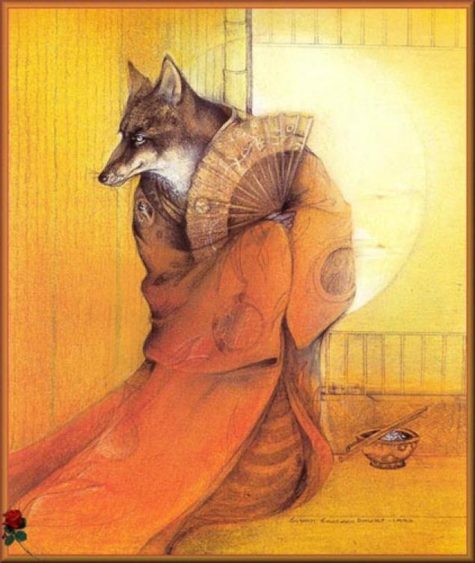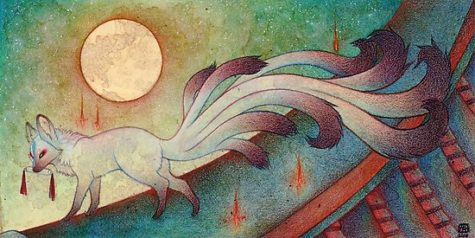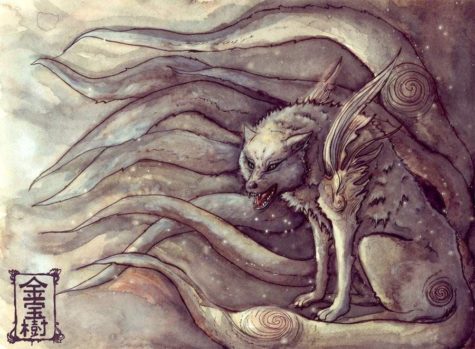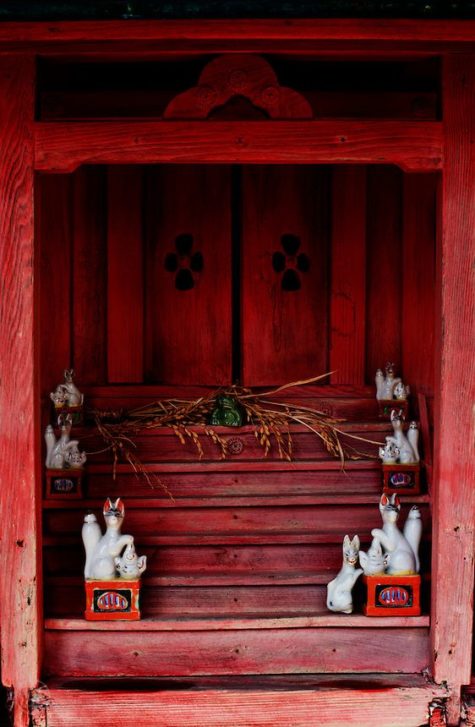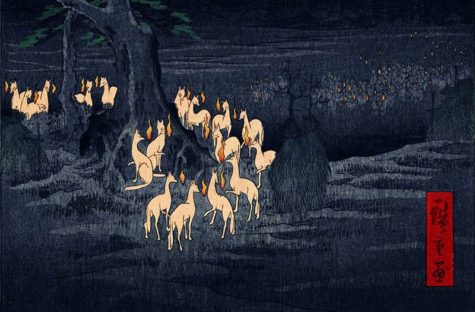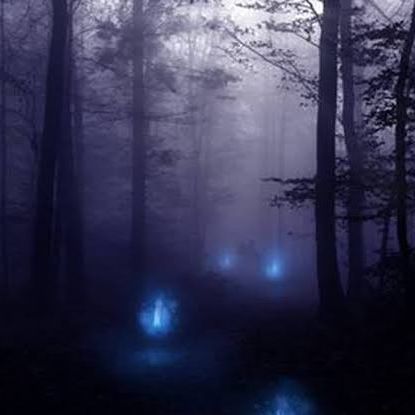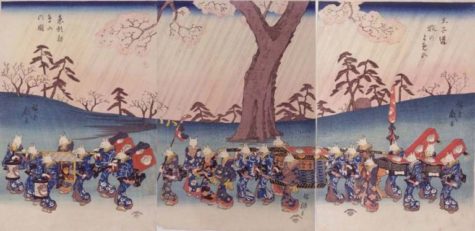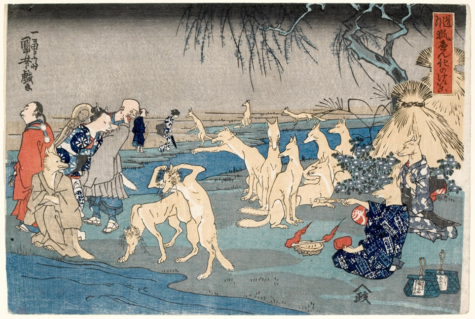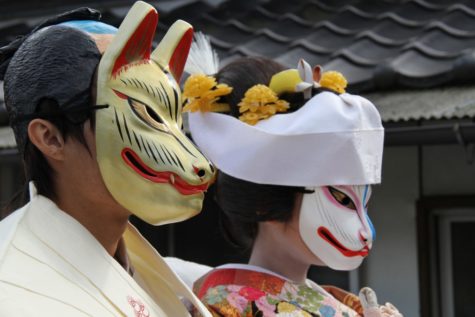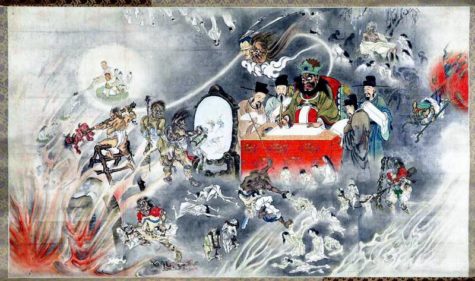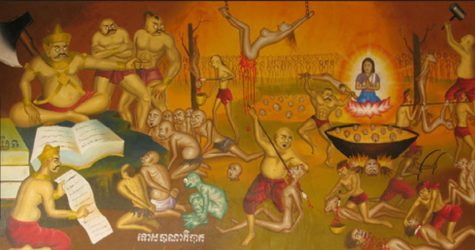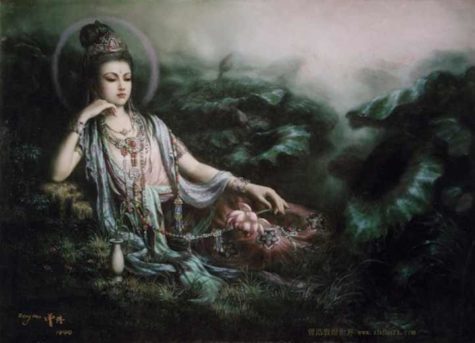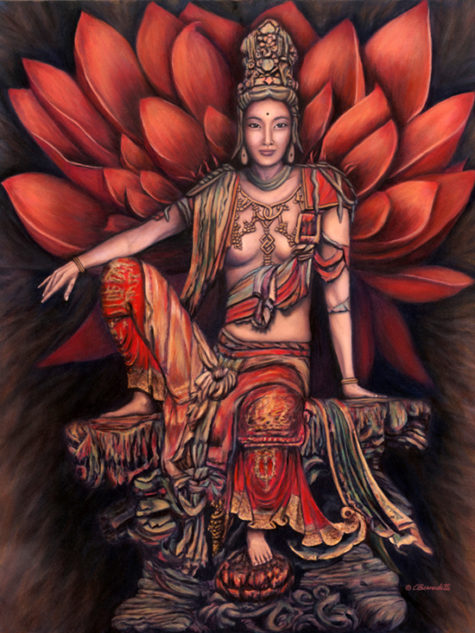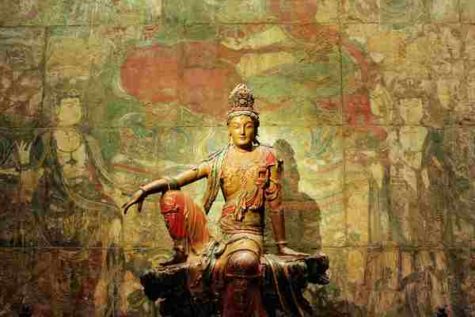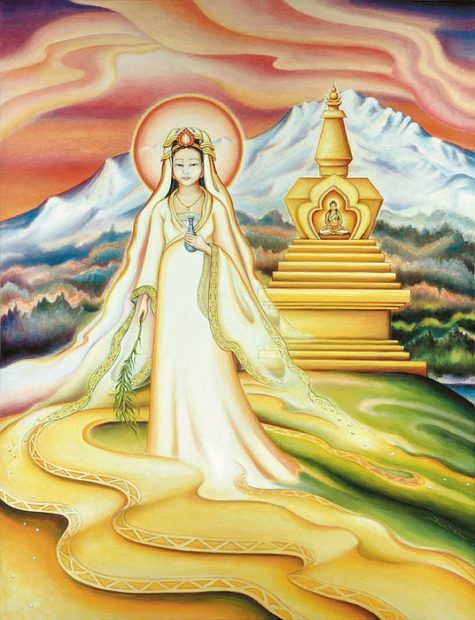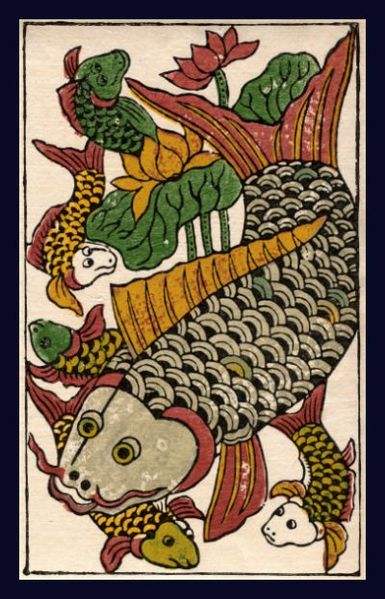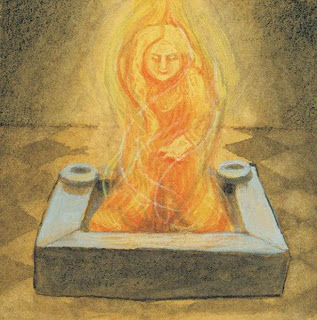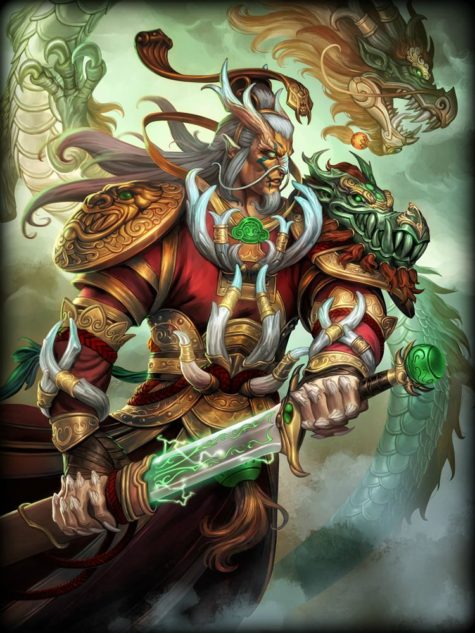Asian Gods and Goddesses
- Also known as: Kitsune (Japan); Kumiho (Korea)
- Origin: East Asia
Fox Spirits are not ordinary foxes. They are spirits whose true form is a fox shape in the same way that other spirits take the form of humans, cats, snakes, or birds, Fox Spirits may resemble ordinary foxes. The older a Fox Spirit gets, the more powerful it becomes. Age and power may be displayed by additional tails. The most powerful and ancient Fox Spirits are nine-tailed foxes.
Theoretically, ordinary foxes can eventually evolve into Fox Spirits in the way that humans can evolve into spirits, too.
Most Fox Spirits are shape-shifters; they can take many forms, including that of humans. Often they appear in the guise of seductive young women; however, any form is possible. Fox Spirits can also shape-shift so that they appear identical to a specific person. Thus, someone may recognize a friend or relative at the door and open it, only to admit the Fox Spirit in disguise.
Fox Spirits, seductive, sneaky, and often treacherous, are staples of modern manga, anime, and other forms of entertainment. Once upon a time, Fox Spirits were considered protectors, teachers, providers, and sponsors of the occult and alchemical arts. Even now, some Fox Spirits are saintly and helpful.
The foxes that serve as Inari’s messengers are miracle workers, understood as sacred and godly.
Among the functions of Chinese Fox Spirits is protection of archivists and librarians. If a book or document cannot be found, ask the Fox Spirits for help. Make an offering alongside the request. Offerings should be proportionate in size to the importance of the request. Then leave the room for a little while to give the spirit space and opportunity to work some magick. If the Fox Spirits have cooperated, whatever you’re looking for should stick out or somehow draw your attention itself.
Fox Spirits may once have been a feature of pre-Buddhist East Asian shamanic religion. Fox Spirits tend to be sexually assertive, female spirits. As centuries passed and, society became more conservative, women were expected to be modest and subservient. Fox Spirits developed a bad reputation and became feared, especially in Japan and Korea.
In China, their reputation is somewhat milder, although some sexual associations exist.
- Fox Spirits cause illness and misfortune.
- They possess victims, similar to possession by demons or dybbuks.
Fox Spirit possession isn’t ritual possession or channeling; it’s involuntary and invariably unpleasant. Degrees of Fox Spirit possession exist, depending upon the innate strength of the Fox and its victim. Some resist better than others. Full possession – true spiritual takeover – may result. Alternatively, only symptoms may manifest. Symptoms of Fox Spirit possession include:
- Hearing voices where none should be heard.
- Insatiable and indiscriminate appetite. The person may eat anything, even food they wouldn’t normally eat; even things humans wouldn’t normally eat.
- Nocturnal sensations of suffocation and paralysis.
- Increasing facial resemblance to a fox. Sometimes the person develops a visible foxy snout.
Eventually the Fox Spirit may push the true individual out, taking over body, mind, soul, and personality – either full time, or just intermittently. The Fox Spirit speaks through the person’s mouth, often indulging in obscenities, frequently sexual, which the person would normally never use.
Although most Fox Spirits are perceived as greedy or power hungry, spiritual motivation may exist, as well; what the Fox Spirit may really desire is a shrine and daily offerings. The only way for them to make their desire known is through a human mouth, similar to African Zar spirits. Sometimes this is enough to satisfy them and the Fox Spirit evolves into an ally rather than an enemy.
Fox Spirits’ very favorite food of all is inarizushi: fried tofu bags (aburaage) filled with sushi rice; however, you can negotiate their actual diet. Feed daily. Foxes get hungry.
Fox Spirits provide for their devotees, although it’s generally believed they do this by redistributing wealth. Just like real foxes are believed to raid chicken coops, so Fox Spirits are believed to rob the neighborhood. What they provide for their devotees rightfully belongs to others, but has been stolen. Very ancient Fox Spirits, however, may have developed the alchemical and magickal skills to actually produce wealth, no stealing required.
Fox Spirits can be exorcised by knowledgeable shamans; however, gifted exorcists tend to be tainted by their very success. Extortion rackets are suspected: the exorcist who specializes in Fox Spirit removal may actually be in cahoots with the Fox Spirit, who may be his servant. No wonder he can exorcise the spirit: the Fox is his familiar who always does his bidding. Independent practitioners are particularly suspect. Exorcisms may also be successfully performed at Inari shrines.
Fox Spirits are also attached to specific families and individuals, whom they may serve in exchange for care, feeding, protection, and veneration, or perhaps because they are ancestral spirits. Fox Spirits run in families. Families who are hereditary owners of foxes typically transmit this hereditary power through the female line.
Association with Fox Spirits may indicate vestigal memories of ancient fox-oriented shamanic religion. For centuries tremendous fear and social stigma have been attached to families rumored to be Fox Spirit owners.
Kitsune no Yomeiri ~ The Fox Wedding
On a day when the sun shines bright and the rain falls, wise parents advise their children to play indoors. It isn’t that they are worried about them catching a cold. No, it is something more mysterious. For on such days the kitsune, the magical foxes of Japan, hold their wedding processions.
In Tokushima, the Kitsune no Yomeiri is a less happy occasion. It was called the Kitsune no Soshiki (Fox Funeral) and seeing one is considered an omen of death.
From Sakurai city in Ibaraki prefecture to Kashihara city in Nara prefecture, tales of Kitsune no Yomeiri appear all over Japan— with the sole exception of the northern island of Hokkaido. Most stories follow similar patterns with only slight variations. There are two phenomena referred to as Kitsune no Yomeiri—the bizarre weather called sunshowers where rain falls in broad daylight; and the procession of foxfire, called kitsune-bi, winding through the mountains late at night.
A description of Kitsune no Yomeiri comes from the book Echigo Naruse published during the Horeki period (1751-1764):
“On dark and quiet nights, in secret places, strings of lanterns or torches can be seen stretching out single file in an unbroken chain more than two miles long. It is a rare site, but an unmistakable one. It can be seen most often in Kanbara county, and it is said that on such night young foxes claim their mates.”
The procession of lights became associated with weddings as it mirrored Japanese wedding ceremonies at the time. Based on traditions established during the Muromachi period (1392–1573), weddings were held at night and the bride was escorted over to her new home by a lamplight parade. This type of ceremony—called the Konrei Gyoretsu (Wedding Procession) —lasted until the mid-Showa period when Western wedding ceremonies replaced traditional Japanese ceremonies.
Legends of the Kitsune no Yomeiri merged with existing stories of kitsune magic and bewitchment. People who tried to follow these foxfire lantern processions would find that they disappeared as soon as they got close—although on rare occasions traces of the ceremony were found. Shunjitsu Shrine in Saitama prefecture was said to be a popular place for fox weddings. Whenever a Kitsune no Yomeiri lit up the night, the mountain road leading to the shrine was covered with fox poop the following day.
In both Niigata and Nara prefectures, Kitsune no Yomeiri was thought to be a good omen for the harvest, with the more lanterns being seen the more fruitful the harvest. A year with no fox weddings made people dread the upcoming famine.
The foxes of Gifu prefecture didn’t just content themselves with lanterns. The foxfire procession was accompanied by the sound of cracking and blazing bamboo, although when examined the following day the forests appeared untouched.
Scientific Explanation for Kitsune-bi
The procession of lamplights is not only a widespread phenomenon in Japan; it is worldwide. Japanese kitsune-bi is different from foxfire in Western legends, which comes from a phosphorescent fungus. It is more akin to the Will-o’-the-wisp, also known as ignis fatuus or “Fool’s Fire.”
The most common explanation is that these fires are the oxidation of the chemical phosphine caused by decaying organic matter, such as can be found in forests. Other suggestions are that they are a mere optical illusion caused by the setting sun. But there is no scientific evidence for either of these theories.
The foxfire procession kind of Kitsune no Yomeiri are rarely seen today. This is most likely due to the 1950’s deforestation of Japan’s native forests and replanting with fast-growing industrial cedar. Whatever magic of the forests that produced the foxfire lights, it is now gone, sacrificed to industry.
Sunshowers and Fox Weddings
The Meiji period Tanka poet Masaoka Shiki wrote:
“When rain falls from a blue sky,
in the Hour of the Horse,
the Great Fox King takes his bride.”
Another strange natural phenomenon goes by the name of Kitsune no Yomeiri, and in the modern era is much better known. On days when the sun shines and it still rains—a weather condition called tenkiame in Japanese or sunshowers in English—foxes are once again thought to hold their wedding ceremonies.
How sunshowers became associated with fox weddings is vague. Some say that it has to do with mountains where foxes are mostly found. There are times when mountains are covered in rain, while the town below is clear. People said that the foxes summoned the rain with their magic to hide their wedding ceremony.
Others just think that because sunshowers are a mysterious occurrence, going against the natural pattern of clouds and rain, that people assumed a supernatural origin and associated it with foxes.
As always, there are regional variations. In agricultural regions the sunshower version of Kitsune no Yomeiri was a good omen, promising rain for the crops and many children for the any new brides lucky enough to be married on such a day. In Tokushima, sunshowers are known as Kitsuneame (fox rain) and not associated with weddings. In Kumamoto prefecture fox weddings are associated with rainbows, and in Aichi prefecture they are associated with hail.
How to See a Fox Wedding
While most people go out of their way to avoid seeing strange phenomena (getting wrapped up in kitsune magic is rarely healthy in Japanese folklore) there are a few rituals for the brave and the curious.
In the Fukushima Prefecture, a bizarre ritual exists of wearing a suribachi mortar on your head and sticking the wooden pestle in your belt, then standing under a date tree. Of course, this only works on the 10th day of the 10th month of the Lunar calendar.
Aichi prefecture has a much easier method—just spit in a well and weave your fingers together. You are said to be able to view the Kitsune no Yomeiri though the gaps in your fingers.
But most stories advise against seeing a fox wedding—foxes are powerful in Japanese folklore, but dangerous. A wise person keeps well away.
Fox Wedding Festivals
Kitsune no Yomeiri remains a popular aspect of Japanese culture and folklore. Many towns hold Kitsune no Yomeiri festivals re-creating the famous processions. Most of these festivals are modern—coming from the 1950s to as recently as the 1990s—and were started as tourist attractions to draw people into town. Local politicians and businesses participate in the festival, and sometimes the fox bride and groom are selected as a sort of “beauty pageant.”
Not all are modern tourist traps, however. The Yokaichi city, Mie prefecture Kitsune no Yomeiri procession to Suzakiha Mamiyashimei Shrine dates back to the Edo period, and is a ritual to drive out evil spirits and ask for blessings for the harvest.
The festival in Kudamatsu city, Yamaguchi prefecture, has also been held since ancient times, although it bears little relationship to popular images of the Kitsune no Yomeiri. It involves asking the blessing of a pair of white fox deities whose wedding ceremony is re-enacted every year on November 3rd. More about this festival can be found at The Pagan Calendar.
Sources:
- The Encyclopedia of Spirits
- Hyakumonogatari Kaidankai
Also known as The Ten Kings, or the Ten Judges of Hell; the Ten Kings of Hell are afterlife judges. They derive from Chinese Taoist tradition, filtered through Japanese Buddhism.
- Those who have clearly lived exemplary lives travel to Paradise.
- Those who have been clearly wicked travel to a punishment realm.
But what of those whose actions are more ambiguous? Those who may have performed both good and bad deeds while alive? Where do they go? That’s for the Kings of Hell to decide.
The Kings of Hell preside over a series of afterlife trials intended to determine the fate of the dead soul. The person’s actions while alive, both positive and negative are weighed, analyzed and discussed. Jizo serves as the defense attorney for dead souls and always attempts to present human actions in the best possible light. Final outcome, however is up to the Kings of Hell.
The Eighteen Levels of Hell
Chinese legends speak of the “Eighteen Levels of Hell”. Each court deals with a different aspect of atonement and different punishments; most legends claim that sinners are subjected to gruesome tortures until their “deaths”, after which they are restored to their original state for the torture to be repeated.
The concept of the eighteen hells started in the Tang dynasty. The Buddhist text Wen Diyu Jing mentioned 134 worlds of hell, but was simplified to the Eighteen Levels of Hell for convenience. Sinners feel pain and agony just like living humans when they are subjected to the tortures listed below. They cannot “die” from the torture because when the ordeal is over, their bodies will be restored to their original states for the torture to be repeated. The following is a list of common punishments and tortures in the hells:
- Mountain of Knives: Sinners are thrown off cliffs and land on mountainous terrain with sharp blades sticking out. Some depictions show offenders climbing trees with knives or sharp thorns sticking out of trunks and branches.
- Cauldron torture: Sinners are fried in cauldrons of oil.
- Dismemberment: Sinners are dismembered by various means, including sawing, slicing into half, mashing/pounding into pulp, being crushed by rocks/boulders, being run over by vehicles, etc.
- Grinding torture: Sinners are put into a grinding machine and ground into a bloody pulp.
- Burning: Sinners are set aflame or cast into infernos.
- Paolao torture: Sinners are stripped naked and tied to a large hollow metal cylinder with a fire lit at its base.
- Boiling liquid torture: Boiling liquids are forced down sinners’ throats or poured on parts of their bodies.
- Tortures involving removal of body parts or organs: Tongue ripping, eye gouging, teeth extraction, heart digging, disembowelment, skinning, etc.
- Ice World: Sinners are frozen in ice. Some depictions show unclothed sinners suffering frostbite in an icy world. Their bodies eventually fall apart or break into pieces.
- Scales and hooks torture: Sinners are pierced with hooks and hung upside-down. Some depictions show sinners having nails hammered into their bodies.
- Pool of Blood: Sinners are cast into a pool of filthy blood, where they drown. Blood spills from all bodily orifices.
- Tortures involving animals: Sinners are trampled by cattle, gored by animals with horns or tusks, mauled or eaten by predators, stung or bitten by poisonous species, etc.
- Avīci: The period of suffering in this chamber is the longest. It is reserved for sinners who have committed heinous crimes, including the Five Grave Offences.
Some literature refers to eighteen types of hells or to eighteen hells for each type of punishment. Some religious or literature books say that wrongdoers who were not punished when they were alive are punished in the hells after death.
The Five Grave Offences:
Ānantarika-karma or ānantarika-kamma is a heinous crime that through karmic process brings immediate disaster. They are called ‘anantarika’ because they are ‘an’ (without) ‘antara’ (interval), in other words the results immediately come to fruition in the next life, i.e. the participant goes straight to hell.
These are considered so heinous that Buddhists and non-Buddhists must avoid them. According to Buddhism, committing such a crime would prevent the perpetrator from attaining the stages of sotāpanna, sakadagami, anāgāmi or arhat in that lifetime. The five crimes are:
- Intentionally murdering one’s father.
- Intentionally murdering one’s mother.
- Killing an Arhat (fully enlightened being).
- Shedding the blood of a Buddha.
- Creating a schism within the Sangha, the community of Buddhist monks, nuns and pariṣā who try to attain enlightenment.
In Mahayana Buddhism these five crimes are referred to as pañcānantarya and are mentioned in “The Sutra Preached by the Buddha on the Total Extinction of the Dharma”.
Source: Wikipedia
The Goddess of Mercy
She Who Hears the Cries of the World
- Also known as: Guan Yin, Kuan Shih Yin, Phat Ba Quan Am, Sung-Tzu-Niang-Niang
- Alternative spellings: Quan Yin, Guan Yin, Kuan Yin,
Kwan Yin is the very essence of mercy and compassion; among the most beloved and well known of all spirits. Technically, Kwan Yin is considered a Bodhisattva, venerated as such throughout the Buddhist world but she also possesses the stature of a goddess and many consider her to be one, not just modern Western goddess devotees but also in East Asian folk religion.
Kwan Yin is a spiritual phenomenon; she transcends religious boundaries and is also found in Taoist and Shinto shrines, even in the shrine of her main rival, the Lady of T’ai Shan.
- Kwan Yin is a great favorite of independent practitioners and goddess devotees everywhere.
- Kwan Yin protects the helpless, particularly women, children and animals.
- She bestows good health and fertility.
- She guides and protects travelers especially seafarers and sky travelers.
- In recent years, Kwan yin has emerged as the guardian of air travel.
- She protects against attack from either animals or humans.
- She breaks cycles of rebirth, punishment and retribution.
- Kwan Yin provides protection in the realms of the living, the dead and anywhere else.
Kwan Yin’s true identity is subject to debate. Officially she is an aspect of the Bodhisatva Avalokiteshvara. The Lotus Sutra, which describes Avalokiteshvara, was among the first Buddhist texts translated into Chinese. Avalokiteshvara translated into Chinese is Kwan Shih Yin. The first Chinese statues of Kwan Shih Yin aka Avalokiteshvara, appeared in the 5th century CE and depict him as a slight, graceful, androgynous man.
Kwan Yin as we know her today first emerged from China’s wild northwest frontier, by the Silk Road, sometime between the 7th and 9th centuries CE and began to move into the Chinese heartland during the 9th and 10th centuries along with detailed legends of her life, which do not correspond to Avalokiteshvara but to the Taoist goddess, Miao Shan. Kwan Yin may really be Miao Shan assuming the official guise of Avalokiteshvara as Buddhism was then socially dominant while Taoism was disparagingly considered folk religion. Her strong identification with horses may also indicate her origins on the western frontier.
Alternatively, many believe Isis, Mary Magdalen, and/or Mary, Mother of Christ traveled the length of the Silk Road, finally emerging as Kwan Yin or that their images may have served as a portal for a frontier spirit. Whoever she is, she is entirely good. The desire of so many individuals and traditions to claim Kwan Yin testifies to her appeal and power.
- Favored people:
Women, children, exiles and travelers but Kwan Yin vows to respond to anyone who calls out her hame in his or her moment of fear or suffering. She offers aid, mercy and compassion to anyone who suffers. She helps not because of who you are, but because of who she is.
- Iconography:
Kwan Yin has many forms. She is typically depicted as a kind, beautiful woman dressed in white. In her fertility goddess path, she carries at least one child. These statues closely resemble images of Isis or the Madonna. Kwan Yin is depicted with one-thousand eyes and one thousand arms indicating her ability to see all and help all. Kwan Yin may be accompanied by her acolytes, a small girl and boy.
However, Kwan Yin is a goddess of the masses. Not everyone can afford a statue, and so Kwan Yin’s name or even her title, the Goddess of Mercy, written on a piece of paper and posted where it is visible is considered just as powerful and effective as an image.
Correspondences:
- Color: White
- Animal: All are sacred to Kwan Yin but especially horses
- Bird: Peacock
- Tree: Willow
- Gem: Pearl
- Metal: Iron
- Mount: Lion or hou, a mythic lion-like creature; dragon; giant carp; dolphin
- Number: 19
- Sacred days: The first and 15 of each lunar month, the New Moon, and the Full moon.
Attributes: Rosary, lotus, a sutra vase from which pours compassion, a willow branch symbolizing her powers of exorcism (according to Chinese shamanism, demons flee from the presence of willow); fish basket
Feast days: The 19th day of the 2nd Chinese month is Kwan Yin’s birthday. The 19th day of the 6th Chinese month commemorates when Kwan Yin became a Buddha. The 19th day of the 9th Chinese month, the day she first wore her sacred pearls.
Offerings: Oranges, pomegranates, spices, incense; Iron Goddess Oolong tea; offerings on behalf of needy women, children, and wildlife.
Note: Kwan Yin is a vegetarian. Her image on restaurant menus often indicates that vegetarian fare is served. Give appropriate offerings (i.e. don’t give her steak). Many devotees adopt a vegetarian diet in her honor but even those who do not, traditionally eat vegetarian on her sacred days.
Kwan Yin epitomizes goodness. No one is kinder, more compassionate or more benevolent. Kwan Yin doesn’t possess a single malevolent or malicious impulse. She is also exceptionally responsive, as evidenced by her world-wide veneration. If you are new to spirits or are generally afraid of them, Kwan Yin may be the right spirit for you.
From: Encyclopedia of Spirits
- Also known as: Ca Ong; Mr. Fish; Grandfather Fish; Lord Fish
- Origin: Vietnam
- Favored people: Fishermen and men in general; Sir Fish is a men’s deity.
Sir Fish is not exactly a fish: he’s a whale. Sir Fish, King of the Sea, is a guardian deity in the form of a whale. He is the patron of fishermen whom he protects out on open waters.
Sir Fish is widely venerated along the central and southern coasts of Vietnam. Festivals are held in his honor. He may be an incarnation of the Lord of the South Seas. Sir Fish is associated with prominent Vietnamese male military or naval heroes and may be enshrined alongside them.
Whales are Sir Fish’s sacred messengers and must be treated with immense respect. Disrespect directed toward his messengers is the equivalent of disrespect directed towards Sir Fish.
The first person to catch sight of a whale carcass is considered as one of Sir Fish’s elder sons and must arrange and observe appropriate funeral rites for the whale. The whale carcass must be respectfully interred. In return, the man will receive blessings of good fortune from Sir Fish.
Sacred sites: Whale bones that have washed ashore are enshrined in his many temples along vietnam’s southern coast.
From: Encyclopedia of Spirits
Goddess Fuji, also known as Fuchi, is a powerful and almighty goddess of fire. The ancient people of Japan depended on her favor and her strength. The majestic mountain, Fuji was even named after her. Both seem beautiful and soft like a light breeze, but their fire can be very powerful and destructive. Fuji is the goddess of fire; honor her and release her into your life.
Fuji, goddess of fire, is much like her own mountain; she is a volcano. Almost always she is calm and peaceful, but she can unleash a terrible blaze of fire destroying all that stands in her way when angry. Yes, fire can be impossible to beat, but it can also be simple and good. Its energy lights our way, cooks our food, warms and dries us. At times we all enjoy the warm flickering of a fire. Sometimes we love them so much that we imitate them with a gas fire if we don’t have a fireplace. Fuji as a fire goddess can be called upon to help us control the fire that sets so many things ablaze.
Fuji, like everyone else, is not perfect. Take this story, for example. Once the Goddess Fuji was fighting with Mt. Hakusan’s god over whose mountain was taller. Amida Buddha created an ingenuous way to measure: he connected the two mountain peaks with a long pipe and poured water in one end. Fuji was proud until the water came rushing down on her head. However, her humiliation didn’t last long. Fuji struck Mt. Hakusan with eight blows, creating the eight craters near its summit.
You do not need a volcano to honor Fuji. Fuji dwells in the hearth of every home. The hearth or fireplace serves as her altar. Offerings to Fuji include millet, beer, rice beer, and a well tended flame. These offerings may be fed directly to the fire. Your gift can be as simple as a single candle flame.
To honor and respect Fuji, you can use a fire ritual. Ancient fire rituals are almost always associated with women and goddesses. Fire rituals have survived since we first tamed fire to keep warm in caves. The fireplace is still the center of many homes, and candles are still lighted at birthdays and funerals. Fire rituals also exist for cleansing and purifying in traditional and modern medicine.
Known as the woman’s best friend, Fuji protects reproductive health and bestows fertility. An ancient ritual to counteract infertility involved having the barren woman lie on another woman’s fresh afterbirth while a circle of women surrounded her, invoking Fuji’s blessings to allow her to conceive. She also protects children. Fuji’s essence is contained in fireplace ashes. These may be collected into small bags and worn or carried as protective amulets.
From Crystal Vaults and other sources
Attributes: Flaming pearl, red coral branch.
Realm: The Dragon King of the Sea lives in an underwater palace formed from coral. The exact location is subject to speculation: arguments are made for the Sea of Japan or the Yellow Sea.
Sacred Date: Taeborum, the Dragon Festival is celebrated in Korea on the first full moon of the lunar calendar. The Dragon King is invoked and honored at the harbor. Women wade into the river to launch miniature boats bearing lit candles. Written wishes and messages to the Dragon King are attached to the boats.
Dragon kings appear in the mythology of various East Asian people; they may or may not be the same spirit. Although there are many dragon spirits resident in the sea, the Dragon King is their chief, lord, and master.
The Dragon King is the lord of water; he controls precipitation and thus helps or hinders agriculture. He controls sea waters, stilling them as desired or raising storms. He remains an important deity for sailors and those who fish or otherwise ply the waters. He is not limited to salt water but has dominion over rivers, too.
According to Chinese myth, the Dragon King of the Sea lives in a beautiful underwater palace. Crabs and lobsters serve as his courtiers. In Korea, the Dragon King is the complementary power to the Mountain Spirit: they represent yin and yang respectively. Even though the Dragon King is male, he epitomizes ying energy.
The Dragon King has a beautiful daughter, often depicted in human form riding a dragon similar to images of the Japanese goddess, Benten. The Dragon King and his family are master magicians and transformation artists. They are not restricted to only one form.
From Encyclopedia of Spirits
